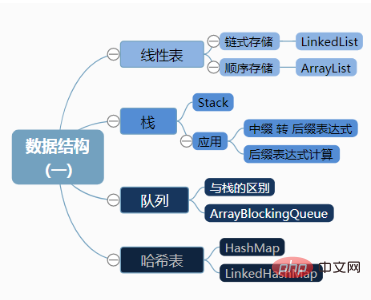Java's nine major data structures

Java's nine major data structures
Stack, TreeMap, Vector, ArrayList, LinkedList, HashMap, HashSet, LinkedHashSet, SortedSet, these classes are respectively Implemented the Map and Collection interfaces.

Java Map interface
The keys and values in the Map interface are mapped one by one. Yes Get the value by key.
Given a key and a value, you can store the value in a Map object. Afterwards, you can access the corresponding value through the key.
When the accessed value does not exist, the method will throw a NoSuchElementException exception.
When the type of the object and the element in the Map When the types are incompatible, a ClassCastException will be thrown.
When a Null object is used in a Map that does not allow the use of Null objects, a NullPointerException will be thrown.
When trying to modify a read-only Map, an UnsupportedOperationException will be thrown.
Java Collection Interface
| Interface Description | |
|---|---|
| Collection interface |
Collection is the most basic collection interface. A Collection represents a group of Objects, that is, elements of Collection. Java does not provide direct inheritance from Collection. Class, only provides sub-interfaces inherited from (such as List and set). Collection interface stores a set of non-unique, unordered objects. |
| List interface |
The List interface is an ordered Collection. Use this interface to accurately control the insertion of each element. The position of the element in the List can be accessed through the index (the position of the element in the List, similar to the subscript of the array). The index of the first element is 0, and the same element is allowed. List interface stores a set of non-unique, ordered (insertion order) objects. |
| Set |
Set has exactly the same interface as Collection, but the behavior is different. Set does not save duplicate elements. Set interface stores a unique, unordered set of objects. |
| SortedSet | Inherited from Set to save an ordered set. |
| Map |
The Map interface stores a set of key-value objects and provides a mapping from key to value. |
| Map.Entry | Describes an element (key/value pair) in a Map. Is an internal class of Map. |
| SortedMap | Inherited from Map, keeping Key in ascending order. |
| Enumeration | This is a traditional interface and defined method through which you can enumerate (obtain one at a time) elements in a collection of objects. This traditional interface has been replaced by iterators. |
The above is the detailed content of Java's nine major data structures. For more information, please follow other related articles on the PHP Chinese website!

Hot AI Tools

Undresser.AI Undress
AI-powered app for creating realistic nude photos

AI Clothes Remover
Online AI tool for removing clothes from photos.

Undress AI Tool
Undress images for free

Clothoff.io
AI clothes remover

AI Hentai Generator
Generate AI Hentai for free.

Hot Article

Hot Tools

Notepad++7.3.1
Easy-to-use and free code editor

SublimeText3 Chinese version
Chinese version, very easy to use

Zend Studio 13.0.1
Powerful PHP integrated development environment

Dreamweaver CS6
Visual web development tools

SublimeText3 Mac version
God-level code editing software (SublimeText3)

Hot Topics
 1359
1359
 52
52
 Square Root in Java
Aug 30, 2024 pm 04:26 PM
Square Root in Java
Aug 30, 2024 pm 04:26 PM
Guide to Square Root in Java. Here we discuss how Square Root works in Java with example and its code implementation respectively.
 Perfect Number in Java
Aug 30, 2024 pm 04:28 PM
Perfect Number in Java
Aug 30, 2024 pm 04:28 PM
Guide to Perfect Number in Java. Here we discuss the Definition, How to check Perfect number in Java?, examples with code implementation.
 Random Number Generator in Java
Aug 30, 2024 pm 04:27 PM
Random Number Generator in Java
Aug 30, 2024 pm 04:27 PM
Guide to Random Number Generator in Java. Here we discuss Functions in Java with examples and two different Generators with ther examples.
 Armstrong Number in Java
Aug 30, 2024 pm 04:26 PM
Armstrong Number in Java
Aug 30, 2024 pm 04:26 PM
Guide to the Armstrong Number in Java. Here we discuss an introduction to Armstrong's number in java along with some of the code.
 Weka in Java
Aug 30, 2024 pm 04:28 PM
Weka in Java
Aug 30, 2024 pm 04:28 PM
Guide to Weka in Java. Here we discuss the Introduction, how to use weka java, the type of platform, and advantages with examples.
 Smith Number in Java
Aug 30, 2024 pm 04:28 PM
Smith Number in Java
Aug 30, 2024 pm 04:28 PM
Guide to Smith Number in Java. Here we discuss the Definition, How to check smith number in Java? example with code implementation.
 Java Spring Interview Questions
Aug 30, 2024 pm 04:29 PM
Java Spring Interview Questions
Aug 30, 2024 pm 04:29 PM
In this article, we have kept the most asked Java Spring Interview Questions with their detailed answers. So that you can crack the interview.
 Break or return from Java 8 stream forEach?
Feb 07, 2025 pm 12:09 PM
Break or return from Java 8 stream forEach?
Feb 07, 2025 pm 12:09 PM
Java 8 introduces the Stream API, providing a powerful and expressive way to process data collections. However, a common question when using Stream is: How to break or return from a forEach operation? Traditional loops allow for early interruption or return, but Stream's forEach method does not directly support this method. This article will explain the reasons and explore alternative methods for implementing premature termination in Stream processing systems. Further reading: Java Stream API improvements Understand Stream forEach The forEach method is a terminal operation that performs one operation on each element in the Stream. Its design intention is




